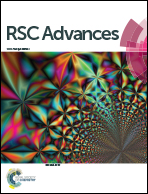Synthesis of hollow mesoporous ruthenium nanoparticles: evaluation of physico-chemical properties and toxicity†
Abstract
Hybrid nanoparticles (NPs) with a mesoporous hollow structure have attracted great interest for biomolecule delivery, due to the easy fabrication process, the multi-functionalization capability for navigating to specific hosts and the high surface area for encapsulating therapeutic moieties. In the present study, hybrid ruthenium NPs were prepared with a dual template method by using colloidal amine functionalized silica particles and poloxamer 407. The results indicate that the size of the NPs can be controlled; smooth, spherical, monodispersed, negative surface charge potential, polycrystalline, and hollow interior architecture particles can be prepared. Also, the Brunauer–Emmett–Teller (BET) analysis shows a specific high surface area of 75 m2 g−1. The hybrid NP system also exhibits fluorescent properties. Thus this system could be a great advantage for cell trafficking. Then, cell cytotoxicity was evaluated in a real-time manner for two different cell lines using the electric cell-substrate impedance sensing (ECIS) system, and the results show that a higher than 100 μg ml−1 concentration is cytotoxic. The negatively charged surface NPs show higher cellular uptake through electrostatic interactions and binding at the cationic sites of the cell membrane, and also show high drug loading and potential for pH sensitive drug release. This hybrid NP system represents a promising nanocarrier for effective and favorable antitumor treatment and theranostic systems.


 Please wait while we load your content...
Please wait while we load your content...